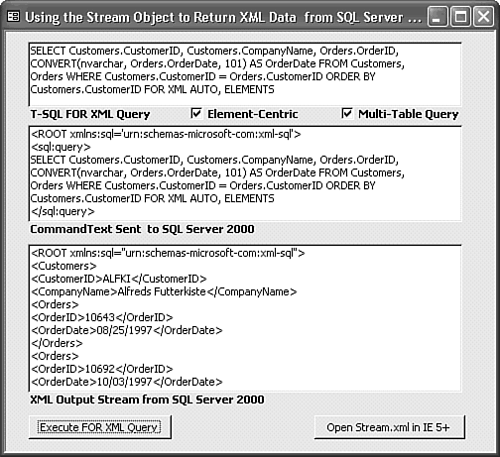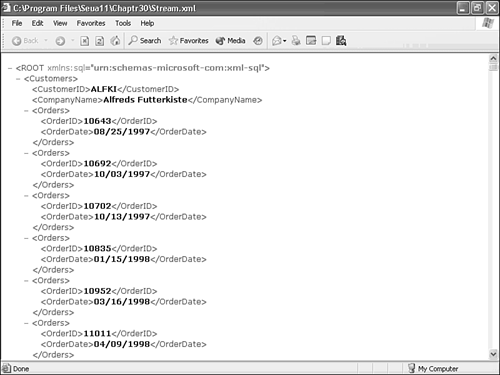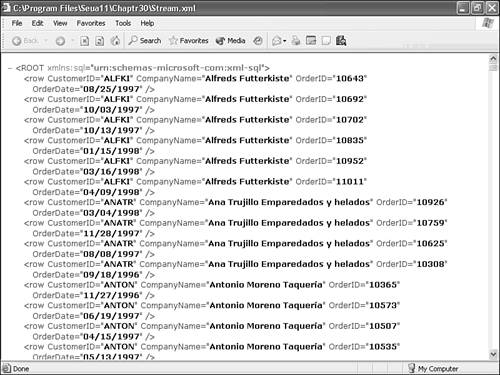Programming Stream Objects
Programming Stream Objects
Executing FOR XML AUTO Queries with the frmStream FormThe frmStream form has unbound text boxes to display a default T-SQL FOR XML AUTO query, the modifications to the query syntax needed to return a well-formed XML document, and the XML document resulting from execution of the Command object that specifies MSSQLXML as the query dialect. To test the frmStream form, do this:
Note Changing the ORDER BY clause from Customers.CustomerID to Orders.OrderID generates a very different XML document strcture. In this case, most Customers elements contain a single nested order; only consecutive orders for a particular customer appear as multiple nested order elements. (See the entry for ROMEY as the first example.) Exploring the VBA Code to Create a Stream ObjectMost of the event handlers and subprocedures used by the VBA code for the frmStream form derive from those of the frmBatch form described earlier. The two important code elements behind frmStream are the Declarations section, which declares the ADODB.Command and ADODB.Stream object variables, and constants for the currently allowable GUID values of the Command.Dialect property, and the cmdExecute_Click event handler (see Listing 30.10). Listing 30.10 Creating a Stream Object from an SQL Server FOR XML AUTO Query and Displaying the Stream in a Text BoxOption Compare Database Option Explicit Private cnnStream As New ADODB.Connection Private cmmStream As New ADODB.Command Private stmQuery As ADODB.Stream 'GUID constants for Stream.Dialect Private Const DBGUID_DEFAULT As String = _ "{C8B521FB-5CF3-11CE-ADE5-00AA0044773D}" Private Const DBGUID_SQL As String = _ "{C8B522D7-5CF3-11CE-ADE5-00AA0044773D}" Private Const DBGUID_MSSQLXML As String = _ "{5D531CB2-E6Ed-11D2-B252-00C04F681B71}" Private Const DBGUID_XPATH As String = _ "{ec2a4293-e898-11d2-b1b7-00c04f680c56}" 'Constants for XML query prefix and suffix Private Const strXML_SQLPrefix As String = _ "<ROOT xmlns:sql='urn:schemas-microsoft-com:xml-sql'>" & vbCrLf & "<sql:query>" Private Const strXML_SQLSuffix As String = "</sql:query>" & vbCrLf & "</ROOT>" Private Sub cmdExecute_Click() 'Use Command and Stream objects to return XML as text Dim strXMLQuery As String Dim strXML As String DimlngCtr As Long On Error GoTo errGetXMLStream strXMLQuery = Me.txtQuery.Value 'Add the XML namespace and <ROOT...> and </ROOT> tags to the query text strXMLQuery = strXML_SQLPrefix & vbCrLf & strXMLQuery & vbCrLf & strXML_SQLSuffix 'Display the CommandText property value Me.txtXMLQuery.Value = strXMLQuery DoEvents 'Create a new Stream for each execution Set stmQuery = New ADODB.Stream stmQuery.Open 'Set and execute the command to return a stream With cmmStream Set .ActiveConnection = cnnStream 'Query text is used here, not an input stream .CommandText = strXMLQuery 'Specify an SQL Server FOR XML query .Dialect = DBGUID_MSSQLXML 'Specify the stream to receive the output .Properties("Output Stream") = stmQuery .Execute , , adExecuteStream End With 'Reset the stream position stmQuery.Position = 0 'Save the stream to a local file stmQuery.SaveToFile CurrentProject.Path & "\Stream.xml", adSaveCreateOverWrite cmdOpenXML.Enabled = True 'Extract the text from the stream strXML = stmQuery.ReadText 'Make the XML more readable with line feeds, if it isn't too long If Len(strXML) < 15000 Then Me.txtXML.Value = Replace(strXML, "><", ">" & vbCrLf & "<") Else If Len(strXML) > 32000 Then 'Limit the display to capacity of text box Me.txtXML.Value = Left$(strXML, 30000) Else Me.txtXML.Value = strXML End If End If Exit Sub errGetXMLStream: MsgBox Err.Description, vbOKOnly + vbExclamation, "Error Returning XML Stream" Exit Sub End Sub This form only uses the DBGUID_MSSQLXML constant; the other three GUID constants are for reference only. ADO 2.6+'s type library doesn't have a "DialectGUIDEnum" or similar enumeration, so you must declare at least the DBGUID_MSSQLXML constant to request SQL Server to return XML data documents in the xml-sql dialect. Comments in the body of the code of the cmdExecute_Click event handler describe the purpose of each Stream-related statement. |
EAN: 2147483647
Pages: 417
 For an example of using the FOR XML AUTO option in SQL Server HTTP template queries,
For an example of using the FOR XML AUTO option in SQL Server HTTP template queries,  Open ADOTest.mdb's or ADOTest.adp's frmStream form. The default query is a simple T-SQL query, similar to that used by the frmBatchUpdate form, with the FOR XML AUTO modifier added. SQL Server's default rowset document style is attribute-centric. Mark the Element-Centric check box to add ELEMENTS to the modifier and return an element-centric document.
Open ADOTest.mdb's or ADOTest.adp's frmStream form. The default query is a simple T-SQL query, similar to that used by the frmBatchUpdate form, with the FOR XML AUTO modifier added. SQL Server's default rowset document style is attribute-centric. Mark the Element-Centric check box to add ELEMENTS to the modifier and return an element-centric document.

